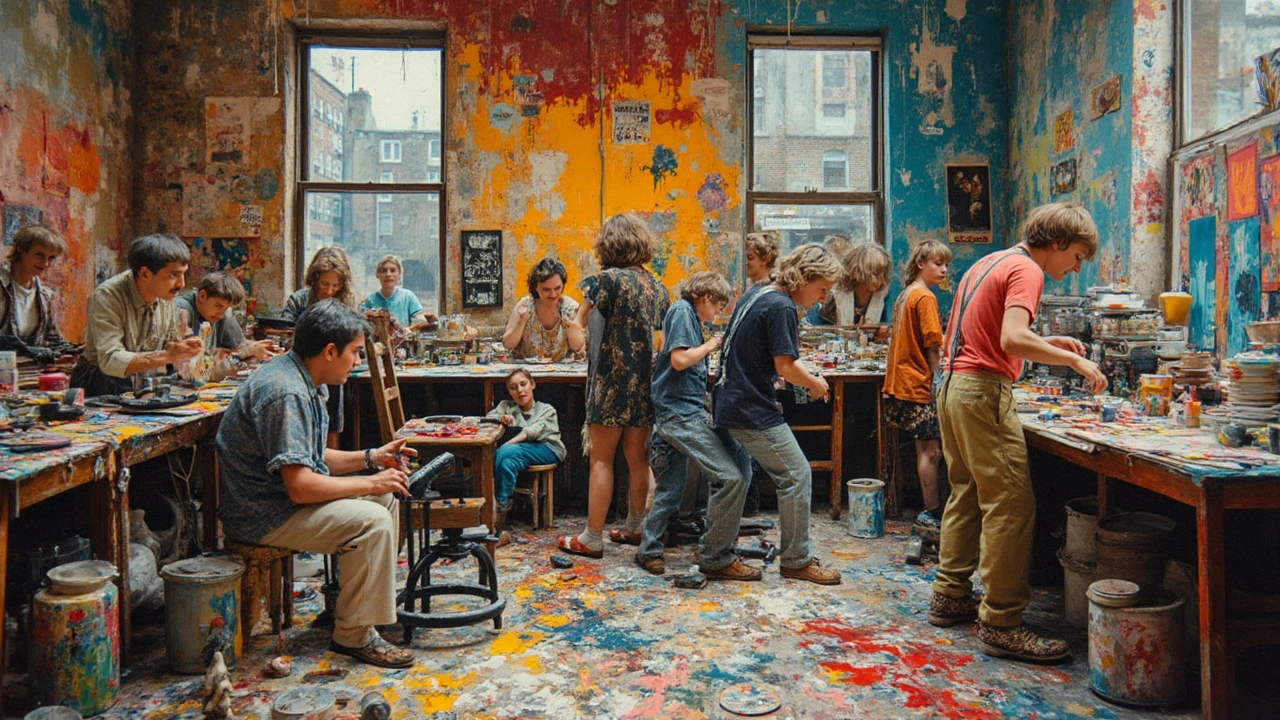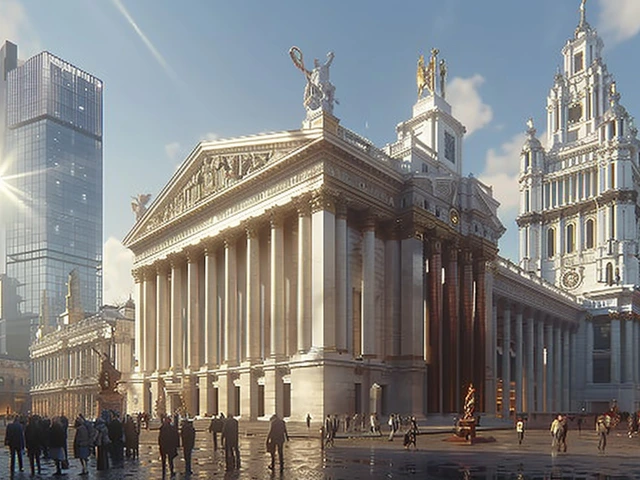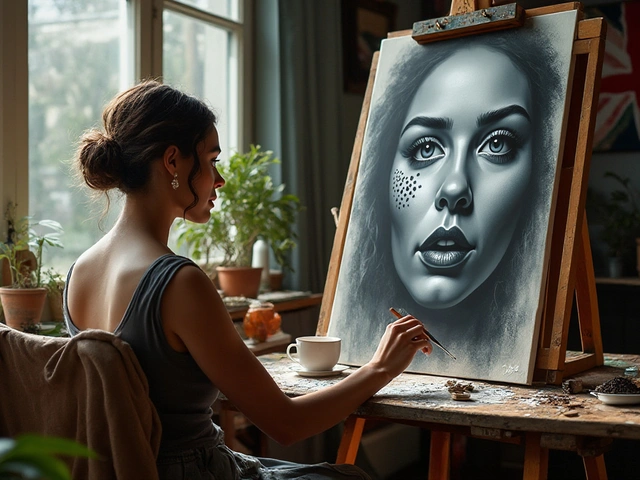Picture an art show where someone smashes a piano on stage or hands out instructions like "light a match and watch it burn. That's it." Sounds random, right? That was exactly the point of Fluxus. This wasn’t your typical museum art; it was bold, unfiltered, sometimes silly, and always unexpected.
Fluxus artists didn’t just want people to look at art—they wanted you to join in. They mixed music, theater, found objects, and even simple actions like opening a door. The goal? To prove that anyone can be an artist, and art can be anything you make it. Forget the idea of the lonely, serious painter. Fluxus was about group energy, sharing ideas, and turning the world upside down.
Understanding Fluxus brings a useful lesson: creativity doesn’t have to be polished or perfect. Sometimes, the wildest ideas create the deepest impact. Curious how this offbeat movement got started and what you can actually try yourself? It’s all in the sections to come.
- What Set Fluxus Apart
- How Fluxus Started and Grew
- The Wild Side: Famous Fluxus Events
- Everyday Objects, Radical Art
- Why Fluxus Still Matters
What Set Fluxus Apart
The thing about Fluxus is that it ditched the drama of traditional art. No giant oil paintings or marble statues here. Instead, the heart of Fluxus was all about breaking the so-called 'rules' of what counts as art. It was anti-elitist. Ordinary things like newspaper clippings, toy pianos, and kitchen utensils were fair game for making art. In fact, artist George Maciunas—the guy often called the movement’s founder—said Fluxus was more about the idea behind the work than the object itself.
Collaboration was also huge. Most art movements have their stars, but Fluxus invited everyone in. Artists from the US, Europe, and even Japan jumped in the mix. Famous names include Yoko Ono, Nam June Paik, and Dick Higgins, but the group was always shifting. No single person was in charge, and anyone could contribute.
Here’s a quick look at how Fluxus broke away from traditional art:
- Blurring art and life: The 'score' for a Fluxus piece could just be a weird instruction, like "draw a straight line and follow it." People really did it.
- Cheap materials: No one spent big money. Anything you find in a junk drawer or hardware store was perfect for a Fluxus event.
- No big egos: Most projects were team efforts, and if anyone got too precious about their work, others poked fun or destroyed it.
- Events, not just objects: Sometimes the only artwork was a performance. Once it was done, all that was left were photos or memories.
To get a sense of how Fluxus compared with the usual museum stuff at the time, check this out:
| Typical 1960s Art | Fluxus Approach |
|---|---|
| Oil paintings and sculpture | Performance, happenings, and sound |
| Expensive, rare materials | Everyday or recycled items |
| Focus on artist's skill | Focus on playful ideas and group work |
| Art shown in galleries | Events in streets, parks, or anywhere |
Fluxus made it clear: art can be funny, cheap, weird, and done with friends—no ‘genius’ label required. This shook up the art world then and still makes a difference now, especially for anyone who’s ever felt shut out of the usual art scene.
How Fluxus Started and Grew
Fluxus got rolling in the early 1960s, fueled by a group of artists who didn’t really care about rules. The name was coined by George Maciunas, a Lithuanian-American artist who loved the idea of constant flow and change. That matches perfectly with what the movement was all about—nothing was meant to stay the same for long.
The first official 'Fluxus Festival' took place in 1962 in Germany. It wasn’t fancy—just some makeshift spaces and a wild set of performances. But it pulled in an international crowd. Soon after, Fluxus spread across Europe, Japan, and the United States. People loved how unpredictable and inclusive it was. Anyone could join, and the art made you question what art even meant. If it felt like the opposite of a formal gallery, you were in the right place.
Here are a few big names to watch out for: Yoko Ono, Nam June Paik, Alison Knowles, and Dick Higgins. All were known for breaking the mold, whether it was with experimental music, strange performances, or wild inventions. The biggest impact? The movement didn’t stick to gallery walls or shiny museums. Everyday life—making toast, dropping objects, scribbling on paper—was fair game for creativity.
What really helped Fluxus take off was its community-driven vibe. Unlike other movements that had one star artist, Fluxus loved collaboration. Maciunas even tried to create "Fluxhouses"—shared living and work spaces in New York—to keep that group energy strong.
| Event | Year | Location |
|---|---|---|
| First Fluxus Festival | 1962 | Wiesbaden, Germany |
| First Fluxus event in the US | 1964 | New York City, USA |
| International Fluxus Shows | 1960s-70s | Worldwide (Europe, Japan, US) |
By the late 1960s, Fluxus had woven itself into music, visual art, performance, and even mail art—yep, people sent wild art projects through the post. Instead of fading out, it morphed and bounced around, later inspiring modern social art and interactive installations. If you go to a gallery and see art that invites you to touch it or change it, you’re probably looking at a hint of Fluxus DNA.
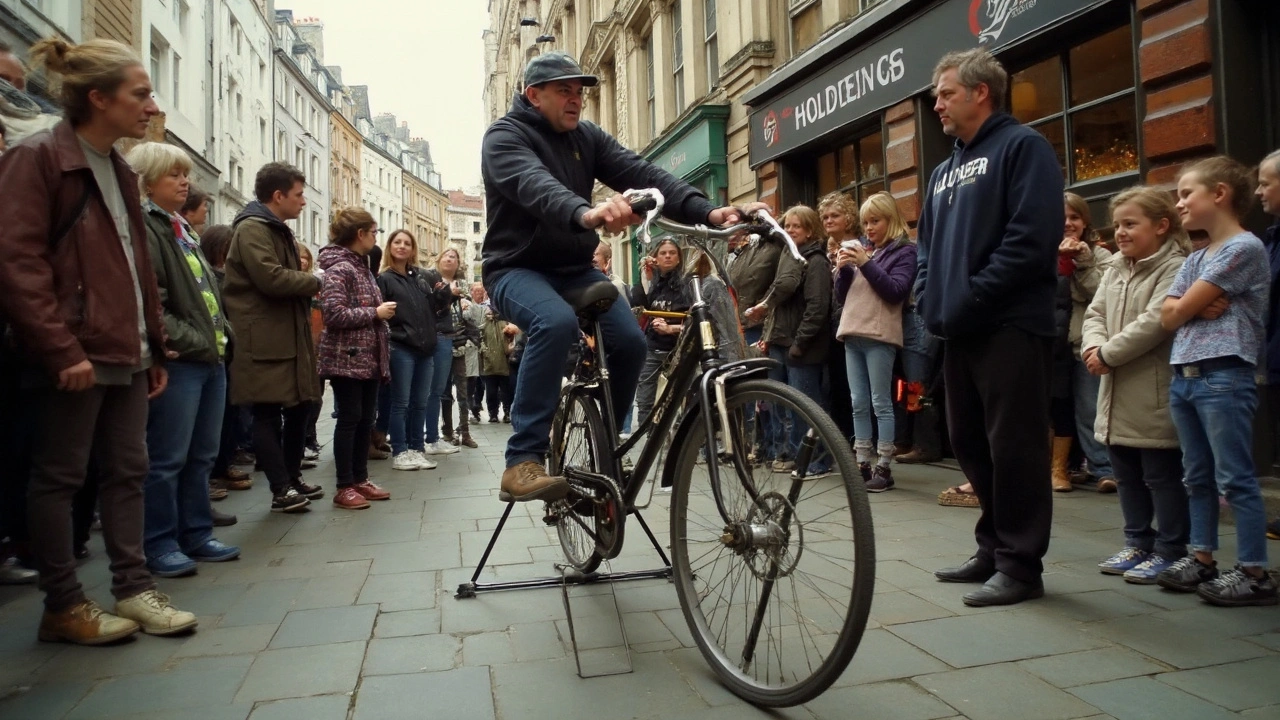
The Wild Side: Famous Fluxus Events
Fluxus artists never did boring. Their events were full of surprises and broke every rule you thought art had to follow. Forget standing quietly in a gallery—Fluxus made you laugh, scratch your head, or even jump in yourself. Here are some famous moments that really put the Fluxus movement on the map.
- Piano Activities (1962 - Wiesbaden, Germany): Ever seen a group attack a grand piano with saws, hammers, and bottles? George Maciunas and his crew turned destroying a piano into a live, noisy spectacle. It freaked people out, but it kicked off a new way to think about sound and music as art.
- Cut Piece (1964 - Japan): Yoko Ono sat on stage, fully dressed, and invited the audience to walk up and cut off bits of her clothing. It was uncomfortable, powerful, and forced everyone to think about roles, consent, and vulnerability. This event still gets talked about in art schools today.
- Ben Vautier's Total Art Match-Box (1965): Nothing fancy—just a box of matches. The instructions? "Strike match and watch." It was about experiencing art in a moment, instead of putting it on a pedestal.
- Eat Art (1962 - New York): Alison Knowles cooked up actual beans and invited everyone to eat together at the AG Gallery. Suddenly, something as ordinary as dinner became a creative event. This challenged the divide between art and everyday life.
These events weren’t about showing off talent in a traditional sense. Instead, they wanted you to question what art even means. As odd as smashing a piano sounds, it got people talking and participating, which was Fluxus’s whole aim. A lot of these performances didn’t cost much—and that was important. Fluxus artists thought art should be for everyone, not just the rich or super educated.
| Year | Event Name | Artist | Location |
|---|---|---|---|
| 1962 | Piano Activities | George Maciunas & Group | Wiesbaden, Germany |
| 1962 | Eat Art | Alison Knowles | New York, USA |
| 1964 | Cut Piece | Yoko Ono | Tokyo, Japan |
| 1965 | Total Art Match-Box | Ben Vautier | France |
If you ever see performance art or interactive art at a gallery or museum, that’s the legacy of these wild Fluxus happenings. They remind us that creativity has no limit—not even a smashed piano.
Everyday Objects, Radical Art
Fluxus artists flipped the script on what counts as art. Instead of oil paintings and marble statues, they went for stuff you’d find on a grocery run—like boxes, forks, soap, or even bits of string. Their message? You don’t need fancy supplies to get creative. Anything can become art if you look at it differently. That’s the core of the Fluxus vibe.
Take George Brecht's "Water Yam" from 1963. He filled a box with simple cards, each showing instructions like “Drip water into a glass” or “Comb your hair.” The idea was to turn boring everyday actions into something surprising. Or think of Yoko Ono’s “Instruction Paintings,” which let you “paint” by following short written commands instead of using brushes or paint at all. These pieces made you realize art isn’t about talent or big skills—it’s about letting your imagination mess with reality a bit.
"Art is what makes life more interesting than art." — Robert Filliou, Fluxus artist
This table shows how Fluxus artists used ordinary items in some of their famous works:
| Artist | Work | Everyday Object | Year |
|---|---|---|---|
| Nam June Paik | TV Magnet | Old television and magnet | 1965 |
| Alison Knowles | Make a Salad | Salad ingredients, huge bowls | 1962 |
| George Maciunas | Flux Box | Matchboxes, small household trinkets | 1964 |
| Ben Vautier | Signatures | Rubber stamps, paper | 1967 |
You don’t need to visit a museum to try this out. Want to spark your own Fluxus-inspired creativity? Try these tips at home:
- Make art from something on your desk—could be tape, keys, or yesterday’s snack wrapper.
- Write instructions for an everyday action and ask a friend to perform it like a performance piece.
- Give a household item a new job—like making music with a spoon or drawing with ketchup.
Fluxus proved that “radical” doesn’t mean complicated. Sometimes, all it takes is seeing your usual stuff in a fresh way.
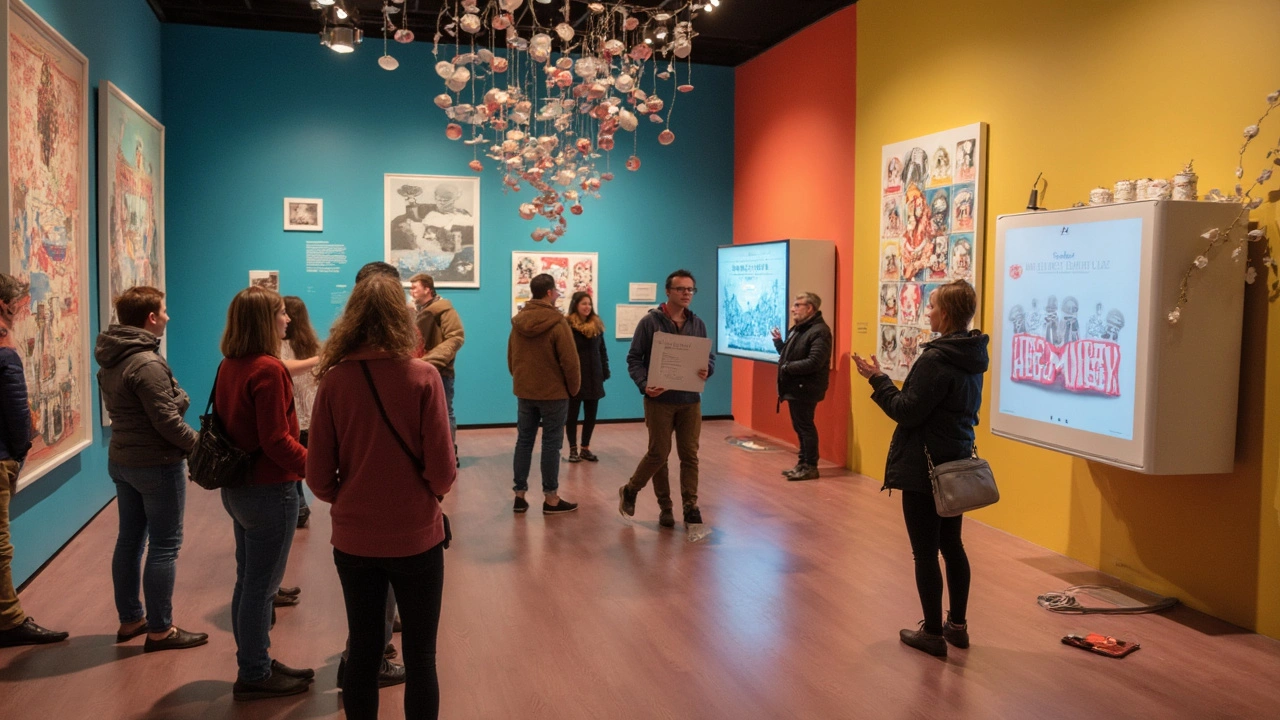
Why Fluxus Still Matters
It’s easy to think of Fluxus as just a blast from the past, but its shake-things-up spirit is everywhere today. That’s not an exaggeration—much of what you see in modern Fluxus art installations, pop-up shows, and interactive museums owes something to those wild, rule-breaking artists from the ‘60s.
First off, Fluxus knocked down the wall between artist and audience. Flash forward to now: galleries invite people to draw on the walls or help finish the art. That DIY attitude? Pure Fluxus.
It also sent a message that art doesn’t need to be expensive, shiny, or tucked away in some fancy gallery. Fluxus encouraged people to use what they already had, from kitchen utensils to scraps of paper. This mindset shows up today in upcycling art and viral “everyday creativity” challenges on social media. Basically, if you’ve ever made something odd and called it art, you’re following in Fluxus footsteps.
Let’s get specific. Yoko Ono’s famous “Cut Piece,” where people were invited onstage to snip her clothes, is mirrored in today’s immersive theater shows. New York’s MoMA even ran a Fluxus-themed family event in 2022 where visitors could create their own scores inspired by Fluxus event cards.
And if you like data, here’s something concrete:
| Year | Major Fluxus Exhibitions | Museum Visitors (est.) |
|---|---|---|
| 2012 | Fluxus 50th Anniversary, Tate Modern | 60,000 |
| 2017 | Fluxus and Friends, Walker Art Center | 40,000 |
| 2022 | MoMA Fluxus Workshop | 8,000 |
These aren’t just numbers. They show how people still show up for Fluxus, decades later, proving it’s not just a footnote in art history. If you’re craving some creative freedom, try out a mini-Fluxus activity of your own. Grab some odd objects, make up rules, invite friends to play along. There’s no wrong way to do it.

